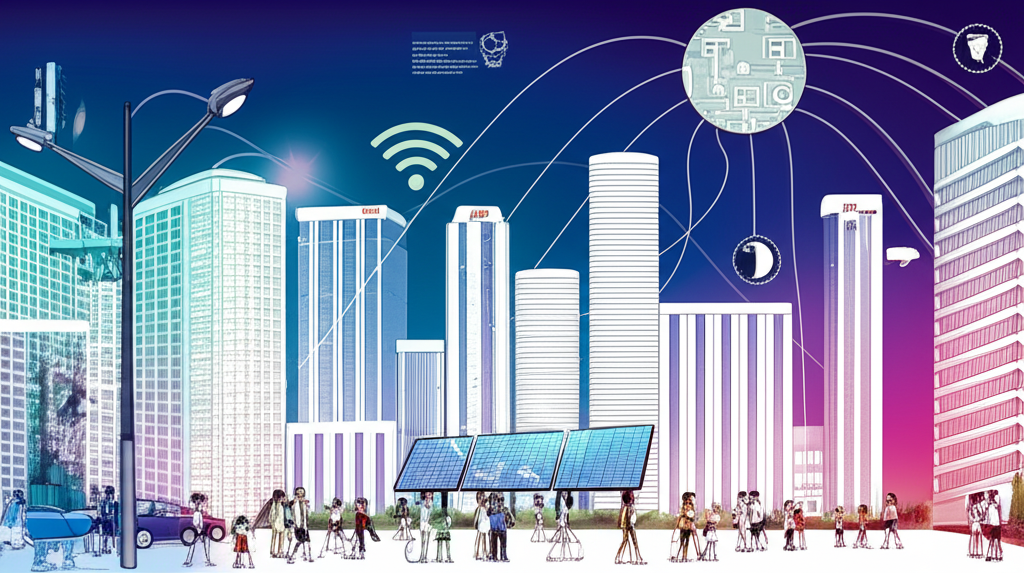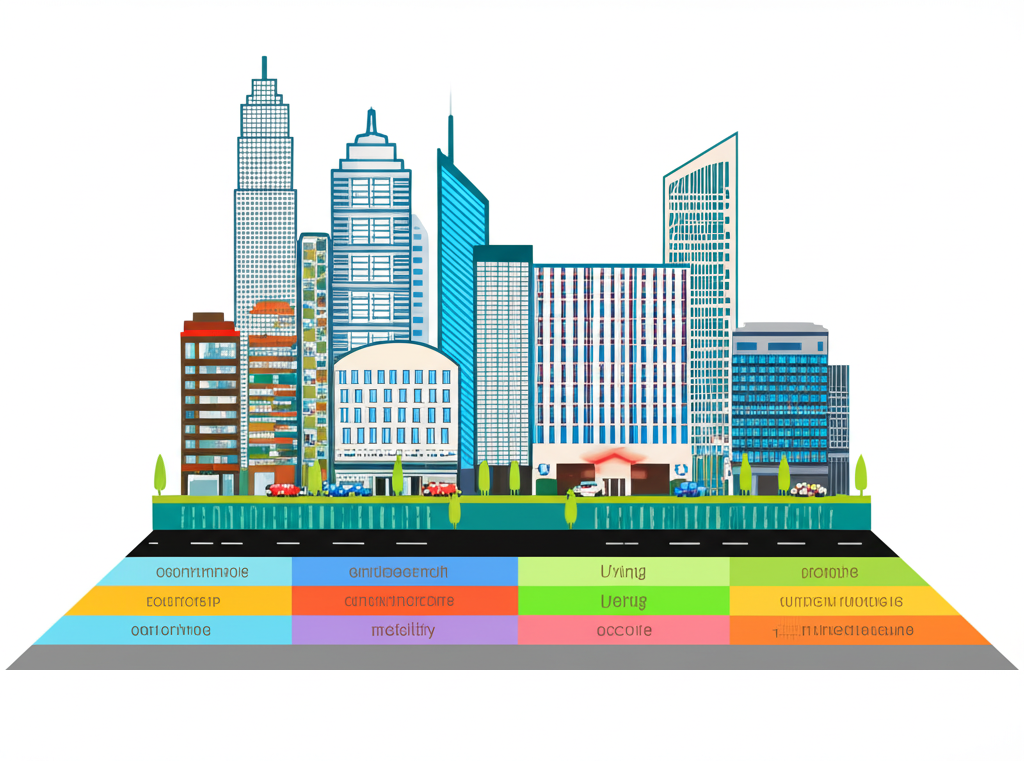Introduction: The Dawn of Smart Urban Futures

As cities swell with growing populations and face mounting environmental pressures, a transformative shift is underway—one powered by data, connectivity, and intelligent design. The concept of the smart city is no longer a speculative vision of the future; it’s a tangible reality reshaping urban life across the globe. By integrating digital infrastructure, real-time analytics, and interconnected systems, smart cities aim to streamline operations, reduce carbon footprints, and elevate the daily experience of residents. For forward-thinking investors, this evolution represents more than just technological innovation—it signals a structural transformation in how urban spaces are built, managed, and monetized. From intelligent transportation to energy-efficient buildings and data-driven governance, the smart city ecosystem is unlocking new avenues for capital deployment with long-term resilience and scalable returns.
What Defines a Smart City and Why Does it Matter to Investors?

At its core, a smart city leverages a network of sensors, communication technologies, and data platforms to monitor, analyze, and improve urban functions. These systems gather information from traffic patterns and energy use to air quality and public service delivery, enabling cities to respond dynamically to changing conditions. Unlike traditional urban development models, smart cities operate on a feedback loop where insights from collected data directly inform decision-making, leading to more efficient resource allocation and better outcomes for citizens. For investors, this shift is significant. It reflects a move from reactive infrastructure spending to proactive, technology-enabled urban management—a model that demands sustained investment across hardware, software, and services. The result is a multi-layered investment landscape where opportunities emerge not only in high-growth tech sectors but also in foundational infrastructure that supports long-term urban sustainability.
The Seven Pillars of a Smart City: A Framework for Investment

To understand where value is being created, it’s helpful to examine the foundational components that define a smart city. These seven pillars form an integrated framework, each contributing to a cohesive urban ecosystem while offering distinct investment pathways:
- Smart Governance: Digital platforms that increase transparency, streamline public services, and empower citizen engagement—such as e-voting, digital identity, and AI-driven administrative tools—create opportunities in civic tech and government-as-a-platform solutions.
- Smart Mobility: From intelligent traffic control to electric vehicle (EV) networks and mobility-as-a-service (MaaS), this pillar addresses congestion, emissions, and accessibility, drawing interest from infrastructure funds and tech innovators alike.
- Smart Environment: Real-time monitoring of air and water quality, smart waste collection, and urban greening initiatives align with climate goals, making them attractive for green investors and ESG-focused portfolios.
- Smart Living: Enhanced healthcare through telemedicine, connected education platforms, and intelligent public safety systems directly impact quality of life, opening doors for investments in healthtech, edtech, and urban security.
- Smart Economy: Digital marketplaces, innovation hubs, and smart zoning policies stimulate entrepreneurship and job creation, particularly in tech-driven urban centers aiming to become regional innovation leaders.
- Smart People: Investments in digital literacy, lifelong learning, and inclusive access to technology ensure equitable participation in the digital economy—an increasingly critical factor for long-term social stability and workforce readiness.
- Smart Infrastructure: The physical and digital backbone of smart cities—including fiber-optic networks, 5G towers, and resilient power grids—represents a cornerstone for all other applications, offering stable, long-duration returns for institutional investors.
Together, these pillars create a self-reinforcing system where progress in one area amplifies gains in others, forming a compelling case for diversified yet interconnected investment strategies.
The Compelling Case for Investing in Smart Cities
The momentum behind smart city development isn’t just technological—it’s economic, demographic, and environmental. As over 70% of the global population is projected to live in urban areas by 2050, cities are under pressure to deliver better services with limited resources. Smart city investments respond directly to this challenge, offering scalable solutions that improve efficiency while generating measurable impact. More importantly, they align with powerful global trends: urbanization, climate action, digital transformation, and the rise of impact investing. This confluence of forces has elevated smart cities from niche pilot programs to mainstream investment themes, attracting capital from pension funds, sovereign wealth entities, and private equity firms.
Market Growth and Economic Impact
The financial scale of this transformation is staggering. According to market analysis, the global smart cities sector was valued at $611.3 billion in 2023 and is forecast to reach $1.3 trillion by 2028—a compound annual growth rate of 16.2%. This expansion is fueled by rising public and private expenditures on digital infrastructure, artificial intelligence, and sustainable urban development. Beyond headline figures, smart city projects generate broad economic ripple effects. They stimulate local employment in construction, engineering, and tech services, attract knowledge-based industries, and enhance a city’s competitiveness on the global stage. For example, cities like Singapore and Barcelona have leveraged smart initiatives to position themselves as innovation hubs, drawing multinational corporations and talent. These secondary benefits reinforce the attractiveness of smart city investments, turning them into catalysts for broader economic revitalization.
Sustainability and ESG Returns
One of the most distinctive aspects of smart city investing is its deep integration with environmental, social, and governance (ESG) principles. Unlike conventional infrastructure projects, many smart city solutions are designed from the outset to reduce emissions, conserve resources, and promote equity. For instance, smart grids enable greater use of renewable energy, while intelligent water systems minimize waste through predictive leak detection. On the social front, digital inclusion programs ensure underserved communities benefit from technological advances, and AI-powered emergency response systems can save lives during crises. From a governance standpoint, transparent data dashboards and participatory platforms enhance accountability. These attributes make smart city assets highly compatible with ESG mandates, enabling investors to meet sustainability targets without sacrificing financial performance. As regulatory pressure increases and stakeholder expectations evolve, ESG-aligned smart city investments are poised to outperform traditional alternatives.
Key Investment Areas and Technological Frontiers
While the smart city concept is holistic, specific sectors are leading the charge in terms of innovation, funding, and deployment. These areas represent the most immediate and high-potential opportunities for investors seeking exposure to urban transformation.
Smart Mobility and Transportation
Mobility remains one of the most visible and impactful domains within smart cities. With traffic congestion costing economies billions annually and transportation accounting for nearly a quarter of global CO₂ emissions, the push for smarter systems is urgent. Investors are backing a range of solutions:
- Autonomous vehicle fleets and the supporting ecosystem of sensors, mapping, and edge computing.
- Expansion of EV charging infrastructure, including fast-charging stations and battery-swapping networks.
- AI-driven traffic management systems that adjust signal timing in real time to reduce delays and emissions.
- Digital platforms that integrate public transit, ride-sharing, and micromobility options into seamless Mobility-as-a-Service (MaaS) experiences.
- Smart parking solutions that use sensors and mobile apps to guide drivers to available spots, reducing urban circling.
Cities like Copenhagen and Seoul have already demonstrated how integrated mobility systems can cut travel times and improve air quality—proof points that de-risk investment and encourage replication elsewhere.
Sustainable Energy and Utilities
Urban areas consume two-thirds of the world’s energy, making them central to the clean energy transition. Smart cities are pioneering decentralized, responsive utility models that increase efficiency and reliability:
- Integration of rooftop solar, wind micro-turbines, and community energy projects into local grids.
- Deployment of smart meters and dynamic pricing models that encourage off-peak energy use.
- Microgrids capable of operating independently during outages, enhancing resilience in disaster-prone regions.
- Waste-to-energy plants and circular economy platforms that convert urban waste into usable resources.
- Smart water networks equipped with sensors to detect leaks, monitor quality, and optimize distribution.
These innovations not only reduce operational costs but also contribute to municipal climate action plans, often unlocking access to green financing mechanisms.
Digital Infrastructure and Connectivity
No smart city can function without a robust digital foundation. High-speed, low-latency connectivity is the lifeblood of urban intelligence:
- Rollout of 5G and full-fiber networks to support massive IoT deployments and real-time data exchange.
- City-wide sensor networks that monitor everything from noise levels to structural integrity of bridges.
- Edge computing nodes that process data locally, reducing latency for time-sensitive applications like emergency response.
- Secure cloud platforms for centralized data management and analytics.
- Advanced cybersecurity protocols to protect critical systems from cyberattacks, a growing concern as cities become more connected.
Investments in digital infrastructure often serve as enablers for other smart city applications, making them foundational and highly strategic.
Smart Buildings and Urban Planning
The built environment accounts for nearly 40% of global energy-related carbon emissions. Smart buildings and intelligent planning are key to reducing this footprint:
- Construction and retrofitting of net-zero energy buildings using advanced insulation, smart HVAC, and automated lighting.
- Integration of building management systems (BMS) that optimize energy use based on occupancy and weather patterns.
- Use of digital twins—virtual replicas of physical assets—to simulate urban development scenarios, test infrastructure resilience, and plan maintenance.
- Adoption of modular construction techniques and sustainable materials to reduce waste and accelerate project timelines.
Cities like Amsterdam and Tokyo are using digital twins to model flood risks and plan evacuation routes, showcasing how predictive analytics can enhance urban safety.
Public Safety and Governance Technologies
Technology is redefining how cities deliver public services and protect their citizens:
- AI-powered video analytics that detect unusual behavior or unattended objects in public spaces, aiding law enforcement.
- Integrated emergency response platforms that coordinate police, fire, and medical services during crises.
- E-governance portals that allow residents to pay taxes, report issues, or apply for permits online, improving access and reducing bureaucracy.
- Smart streetlights equipped with motion sensors, environmental monitors, and even gunshot detection systems.
When implemented responsibly, these tools enhance security without compromising civil liberties, striking a balance between efficiency and ethics.
Funding and Financing Strategies for Smart City Projects
Given the scale and complexity of smart city initiatives, no single entity can shoulder the financial burden alone. A mix of funding models is essential to mobilize the necessary capital and ensure project viability.
Public-Private Partnerships (PPPs)
Public-private partnerships have become a cornerstone of smart city financing, blending public oversight with private-sector agility and capital. In a typical PPP, a government entity partners with a private consortium to design, build, and operate a project—such as a smart lighting network or integrated mobility hub—over a multi-decade concession period. The private partner assumes construction and operational risks in exchange for revenue streams, often derived from service fees or performance-based payments. This model has been successfully applied in cities like Chicago (with its Array of Things sensor network) and Jakarta (smart flood monitoring), demonstrating how collaboration can accelerate innovation while sharing accountability.
Government Funding and Grants
Public funding remains a critical enabler, especially in the early stages of development. National and municipal governments allocate budgets for research, pilot programs, and large-scale infrastructure. Examples include the European Union’s Horizon Europe program, which funds urban innovation projects, and India’s Smart Cities Mission, which has committed over $30 billion to modernize 100 cities. These initiatives often act as catalysts, reducing risk for private investors and validating new technologies before wider deployment.
Private Equity, Venture Capital, and Corporate Investment
Venture capital is fueling breakthroughs in urban tech, with startups developing niche solutions in areas like AI-driven traffic prediction, drone-based delivery, and blockchain for secure data sharing. Private equity firms are stepping in to scale mature companies, while corporate investors—such as Siemens, Cisco, and Alphabet’s Sidewalk Labs—are acquiring startups or launching in-house divisions focused on smart city applications. This influx of private capital is accelerating the pace of innovation and driving down costs through competition and economies of scale.
Innovative Financial Instruments: Green Bonds & Impact Funds
As sustainability becomes a core investment criterion, specialized financial tools are gaining traction. Green bonds—debt instruments earmarked for environmentally beneficial projects—are increasingly used to finance smart city initiatives. Projects involving renewable energy, energy-efficient buildings, and low-carbon transportation are ideal candidates. Similarly, impact funds target investments that deliver both financial returns and measurable social or environmental outcomes. These funds are particularly active in emerging markets, where smart city projects can simultaneously address development gaps and climate vulnerability. According to the International Capital Market Association, green bond issuance hit record levels in recent years, reflecting strong investor appetite for sustainable urban development.
Who is Investing in Smart Cities? Leading Stakeholders and Regions
The smart city investment landscape is shaped by a diverse set of actors, each bringing unique capabilities and objectives to the table.
Global Investment Hotspots and Emerging Markets
While early leadership came from North America and Western Europe, the center of gravity is shifting. Cities like Singapore, London, and Barcelona continue to innovate, but the most dramatic growth is occurring in Asia-Pacific. China’s national smart city strategy has led to the development of over 500 smart cities, while India’s ambitious urban renewal programs are attracting billions in foreign and domestic investment. In the Middle East, NEOM in Saudi Arabia represents a $500 billion greenfield project designed from the ground up as a fully integrated smart city. Meanwhile, Latin American cities like Medellín and Bogotá are leveraging smart technologies to improve public transit and reduce inequality. Even in Africa, urban centers such as Nairobi and Kigali are adopting digital platforms to enhance service delivery and foster innovation.
Key Players: From Tech Giants to Local Innovators
The ecosystem includes a broad spectrum of participants:
- Tech Giants: Companies like IBM, Microsoft, and Google are providing cloud platforms, AI tools, and data analytics engines that power smart city applications.
- Infrastructure Developers: Firms such as Vinci and Skanska are incorporating smart technologies into roads, bridges, and public buildings.
- Specialized Startups: Innovators like Sidewalk Labs (before its pivot), ZenCity, and Urbiotica are solving specific urban challenges with targeted solutions.
- Financial Institutions: Banks and asset managers are launching smart city-themed ETFs, green bonds, and infrastructure funds.
- Public Sector Entities: Municipal governments are not just regulators but active investors and data stewards, shaping the direction of urban transformation.
Challenges and Risks in Smart City Investment
Despite the promise, smart city investments come with notable risks that require careful navigation.
Regulatory Hurdles and Policy Inconsistencies
Urban projects often span multiple jurisdictions, each with its own rules and approval processes. Inconsistent data privacy laws, zoning regulations, and technology standards can delay implementation and increase compliance costs. For cross-border investors, these disparities create uncertainty and complicate scalability. Harmonizing policies through international frameworks or regional agreements could mitigate these challenges.
Data Privacy, Security, and Ethical Concerns
The vast amount of data collected in smart cities raises legitimate concerns about surveillance, consent, and misuse. High-profile incidents—such as unauthorized facial recognition use—have sparked public backlash in several cities. Investors must prioritize projects with strong data governance, transparency, and ethical AI frameworks. Adopting privacy-by-design principles and engaging communities in decision-making can build trust and ensure long-term acceptance.
Funding Gaps and Project Scalability
Many smart city initiatives begin as pilots but struggle to scale due to unclear revenue models or lack of sustained funding. Municipal budgets are often constrained, and private investors may hesitate without proven returns. Blended finance models—combining grants, concessional loans, and commercial capital—can help bridge this gap, particularly in lower-income regions where the need is greatest.
The Future Outlook: Next Frontiers for Smart City Investment
Looking ahead, the evolution of smart cities will be driven by deeper integration, greater resilience, and more personalized services. Emerging trends include:
- Climate Resilience: Investments in flood-resistant infrastructure, heat mitigation strategies, and adaptive urban design will grow as extreme weather events become more frequent.
- Hyper-Personalization: AI will enable tailored services—such as customized public transit routes or real-time health alerts based on environmental conditions.
- Circular Economy Integration: Cities will adopt closed-loop systems for waste, water, and energy, reducing reliance on virgin resources.
- Urban Air Mobility (UAM): Though still in early stages, drone delivery and air taxis could transform logistics and emergency response in dense urban areas.
- Digital Twins at Scale: These virtual models will evolve into living simulations of entire cities, supporting everything from traffic forecasting to pandemic preparedness.
These frontiers offer first-mover advantages for investors willing to back transformative ideas today.
Conclusion: Investing in a Smarter, More Sustainable Tomorrow
Smart cities are not a distant aspiration—they are being built today, one sensor, one network, and one policy at a time. For investors, this represents a rare opportunity to align financial objectives with societal progress. The convergence of digital innovation, sustainability imperatives, and urban growth creates a powerful investment thesis that extends across sectors and geographies. While challenges around regulation, privacy, and funding persist, the trajectory is clear: cities that embrace intelligence, resilience, and inclusivity will thrive in the 21st century. By supporting these transformations, investors do more than earn returns—they help shape the future of human habitation.
Who is investing in smart cities globally, and what are their primary motivations?
A wide range of entities are investing, including institutional investors (pension funds, sovereign wealth funds), venture capitalists, private equity firms, tech giants (e.g., Siemens, IBM, Cisco), infrastructure developers, and national/municipal governments. Their motivations span from achieving significant financial returns and market leadership to addressing urbanization challenges, enhancing public services, and fulfilling sustainability mandates (ESG goals).
What are the most promising sectors for investment within smart cities today?
Highly promising sectors include:
- Smart Mobility: Autonomous vehicles, EV infrastructure, intelligent traffic management.
- Sustainable Energy & Utilities: Renewable energy integration, smart grids, advanced waste management.
- Digital Infrastructure: 5G deployment, IoT platforms, cybersecurity.
- Smart Buildings & Urban Planning: Energy-efficient buildings, digital twins for development.
- Public Safety & Governance: AI-powered surveillance, digital citizen services.
How do public-private partnerships (PPPs) facilitate investment in smart city projects?
PPPs are crucial for smart city investment by allowing governments to leverage private sector capital, expertise, and efficiency. They enable the sharing of risks and rewards, often leading to faster project delivery and innovation. Private entities bring technical know-how and financial resources, while the public sector provides regulatory frameworks, land, and long-term vision, ensuring projects align with public interest.
What are the key financial returns and societal benefits expected from smart city investments?
Financial Returns: Investors can expect robust market growth, long-term asset value appreciation, and returns from innovative technologies. The global smart cities market is projected to reach over $1.3 trillion by 2028.
Societal Benefits: Include improved quality of life, enhanced public safety, reduced environmental footprint, better resource management, increased economic competitiveness, and greater resilience to climate change and other shocks.
Are there specific risks or challenges investors should consider before funding smart city initiatives?
Yes, key risks include:
- Regulatory Hurdles: Inconsistent policies and complex approval processes across different jurisdictions.
- Data Privacy & Security: Challenges in managing vast amounts of urban data securely and ethically.
- Funding Gaps: Difficulty in securing long-term funding and scaling pilot projects.
- Technological Obsolescence: Rapid pace of technological change requiring continuous upgrades.
- Public Acceptance: Ensuring citizen buy-in and addressing concerns about surveillance or digital exclusion.
How do ESG (Environmental, Social, Governance) factors influence smart city investment decisions?
ESG factors are increasingly central to smart city investment. Investments that align with ESG principles, such as those promoting renewable energy (Environmental), improving public health and equity (Social), and fostering transparent governance (Governance), are highly attractive. They can secure green bond financing, attract impact funds, and appeal to a growing segment of investors seeking both financial returns and positive societal impact, thus de-risking investments and enhancing long-term value.
What role do emerging technologies like AI and IoT play in attracting smart city capital?
AI and IoT are foundational to smart cities and significantly attract capital due to their transformative potential. IoT devices collect vast amounts of real-time urban data, which AI then analyzes to enable predictive analytics, optimize services (e.g., traffic, energy), and automate operations. This leads to greater efficiency, cost savings, and innovative service delivery, making investments in these technologies highly appealing for their potential to scale and generate substantial returns.
Which regions or countries are leading in smart city investment and development?
North America and Europe have traditionally led, with cities like Singapore, London, and Barcelona often cited as pioneers. However, the Asia-Pacific region, particularly China and India, is rapidly emerging as a dominant force due to massive urbanization and government initiatives. The Middle East, with ambitious greenfield projects, is also a significant hotspot. These regions are characterized by strong government support, technological innovation ecosystems, and substantial capital deployment.
What is the typical timeline for seeing returns on investment in smart city infrastructure or technology?
The timeline for returns varies significantly based on the type of investment. Technology-focused solutions (e.g., software platforms, IoT sensors) might see returns within 3-7 years. Large-scale infrastructure projects (e.g., smart grids, public transit systems) typically have longer horizons, often 10-20 years or more, due to their significant upfront costs and complex development cycles. Investors often look for a blend of short-term gains from tech innovation and long-term stability from infrastructure assets.
How can individual investors participate in smart city development, beyond institutional funds?
Individual investors can participate in several ways:
- Investing in Publicly Traded Companies: Buying shares of tech companies or infrastructure firms heavily involved in smart city solutions.
- ETFs/Mutual Funds: Investing in exchange-traded funds or mutual funds that focus on smart cities, sustainability, or urban tech.
- Green Bonds: Purchasing green bonds issued by municipalities or corporations funding smart city projects.
- Crowdfunding Platforms: Some platforms may offer opportunities to invest in smaller, local smart city initiatives or sustainable urban projects.
- Venture Capital Funds (indirectly): Investing in venture capital funds that specialize in urban tech startups.

留言